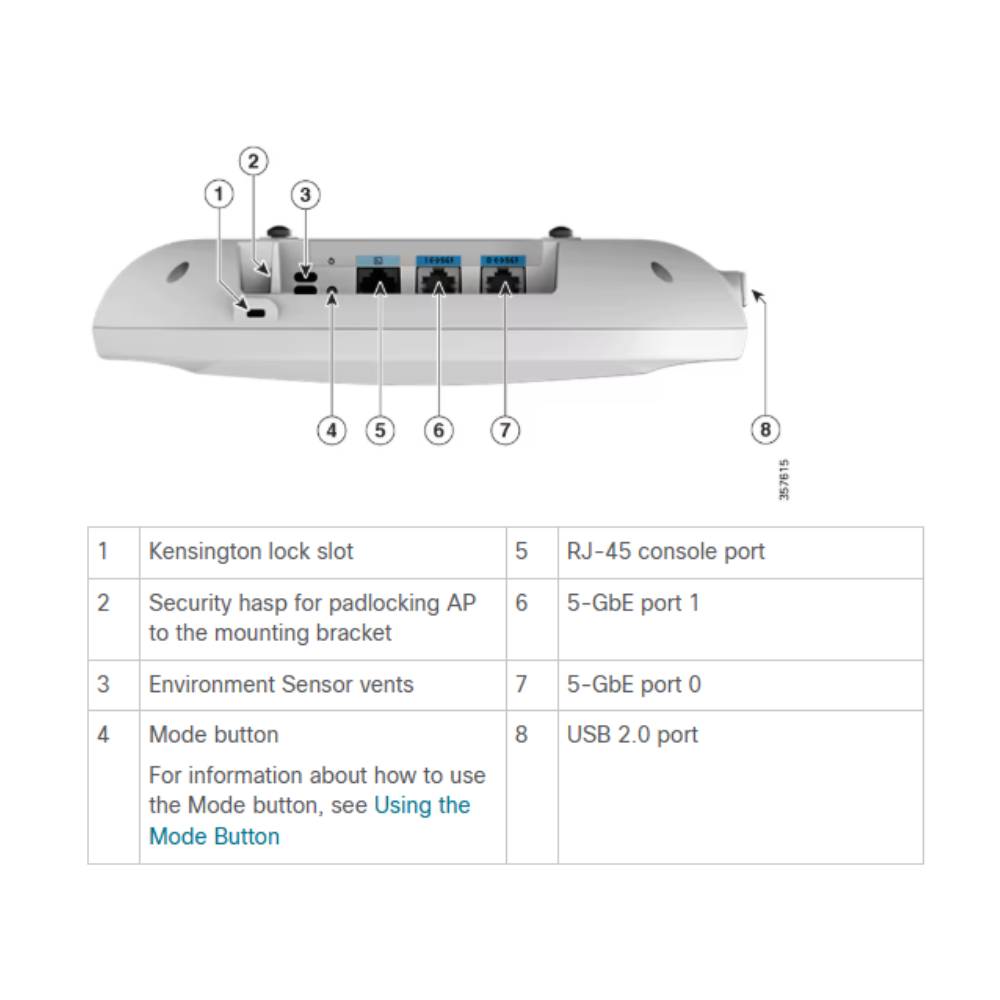All Categories
C9136I-ROW | Cisco Catalyst Wi-Fi 6E Indoor Access Point
£1,807.75 inc VAT
C9136I-E
Availability:
Couldn't load pickup availability
The Cisco catalyst C9136I-ROW is a Wi-Fi 6E (802.11ax) indoor access point + internal antenna. Six radios: 2.4 GHz (4x4), 5 GHz (8x8 and 4x4), 6 GHz (4x4) & BLE
Key Features
- Wi-Fi 6E (802.11ax): The IEEE 802.11ax standard, also known as High-Efficiency Wireless (HEW) or Wi-Fi 6, builds on 802.11ac. It delivers a better experience in typical environments with more predictable performance for advanced applications such as 4K or 8K video; high-density, high-definition collaboration apps; all-wireless offices; and the Internet of Things (IoT). Wi-Fi 6E is Wi-Fi 6 “extended” into the 6-GHz frequency band.
- Environmental sensors: These built-in sensors measure air quality (Total Volatile Organic Compounds [TVOC]), temperature, and humidity, and help ensure a safe working environment, avoiding the need to install an overlay of difficult-to-manage independent sensors.
- Dual 5G Multigigabit Ethernet: Dual Multigigabit Ethernet provides power-redundant uplink ports, each with speeds up to 5 Gbps. All speeds are supported on Category 5e cabling, as well as 10GBASE-T (IEEE 802.3bz) cabling. Redundant powering provides hitless performance during failover.
- Smart AP: Smart AP causes the access point to change its power consumption to reflect its current client load. An access point will typically operate on the radios provided to it irrespective of how many clients are connected. With Smart AP, if there is a small enough number of clients, the access point will automatically reduce the radio stream count, saving power. (Available with a future software upgrade.)
- Band steering: Enhanced to help clients that are 6-GHz capable to leave the 5-GHz radio and connect to the 6-GHz one. Wi-Fi 6E clients are automatically directed to connect to the 6-GHz radio to take advantage of the benefits that that radio offers and free up the 2.4- and 5-GHz radios for legacy clients.
- Uplink/downlink OFDMA: Orthogonal Frequency-Division Multiple Access (OFDMA)-based scheduling splits the bandwidth into smaller frequency allocations called Resource Units (RUs), which can be assigned to individual clients in both the downlink and uplink directions to reduce overhead and latency.
- Uplink/downlink MU‑MIMO technology: Supporting the highest number with 16 spatial streams, Multiuser Multiple Input, Multiple Output (MU-MIMO) enables the access points to split spatial streams between client devices to maximize throughput.
- BSS coloring: Spatial reuse (also known as Basic Service Set [BSS] coloring) allows the access points and their clients to differentiate between BSSs, thus permitting more simultaneous transmissions.
- Target Wake Time: Target Wake Time (TWT) allows the client to stay asleep and to wake up only at prescheduled (target) times to exchange data with the access point. This offers significant energy savings for battery-operated devices, up to three to four times the savings achieved by 802.11n and 802.11ac.
- Intelligent Capture: Intelligent Capture probes the network and provides Cisco DNA Center with deep analysis. The software can track more than 240 anomalies and instantaneously review all packets on demand, emulating the onsite network administrator. Intelligent Capture allows for more informed decisions on your wireless networks.
- Application hosting: Application hosting helps simplify IoT deployments and ready them for the future by eliminating the need to install and manage overlay networks. Using the USB interface, containerized applications and hardware modules can be deployed to reduce cost and complexity. Adding Cisco DNA Center provides workflows and deployment-wide application lifecycle management.
- Bluetooth 5: The integrated Bluetooth Low Energy (BLE) 5 radio enables location-based use cases such as asset tracking, wayfinding, and analytics.
- Container support for applications: Container support enables edge computing capabilities for IoT applications on the host access point.
-
Flexible Radio Assignment (FRA) with quad-radio mode (with future software SW upgrade):
FRA allows the access points to intelligently determine the operating mode of serving radios based on the RF environment and traffic demands. The access points can operate in the following modes:
● Tri-radio mode: One 4x4 6-GHz radio, one 8x8 5-GHz radio, and one 4x4 2.4-GHz radio.● Quad-radio mode: One 4x4 6-GHz radio, Dual 4x4 5-GHz radios, and one 4x4 2.4-GHz radio. With four total 4x4 radios (quad-radio) inside the access point, client device capacity can be increased on demand.The access point’s default mode is tri-radio with 8x8 5-GHz and 4x4 for 6-GHz and 2.4-GHz. It has the ability to split the 8x8 radio into two separate 4x4 5-GHz radios through a future software upgrade, thereby enabling the benefits of FRA while allowing the 2.4- and 6-GHz radios to remain active.
Options
DNA Licences (Optional)
Downloads
Datasheet
About This Product
The Cisco Catalyst 9136 Series Access Points represent the next evolution in enterprise wireless technology, introducing support for the newly available 6 GHz spectrum through Wi-Fi 6E. These access points are built to deliver exceptional performance, robust security, and intelligent network management.
By leveraging the expanded 6 GHz band, the Catalyst 9136 Series offers a more reliable and higher-capacity wireless experience. With two 4x4 radios and one 8x8 radio, these access points are equipped to handle dense environments and demanding applications with ease.
Wi-Fi 6E extends the capabilities of Wi-Fi 6 into the 6 GHz range, enabling faster data rates, reduced latency, and improved overall network efficiency. This new spectrum provides an additional 1.2 GHz of bandwidth, free from legacy device interference, ensuring cleaner and more predictable connections.
Key benefits of Wi-Fi 6E include:
- Increased network speed thanks to the additional spectrum and wider channels.
- Improved reliability and consistency, narrowing the performance gap between wireless and wired connections.
- Enhanced security, with WPA3 encryption required for all Wi-Fi 6E devices, offering stronger protection for sensitive data.
As applications become more critical to daily operations, the Catalyst 9136 Series ensures users have fast, secure, and uninterrupted access—making it a powerful solution for modern enterprise environments.







